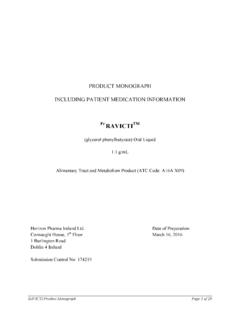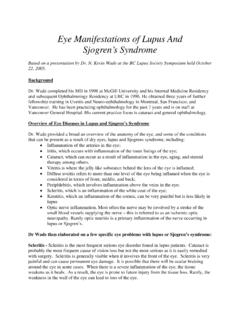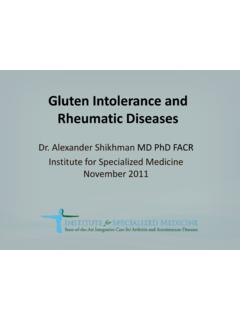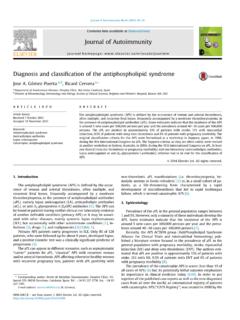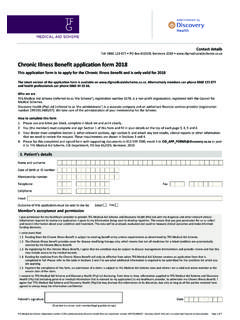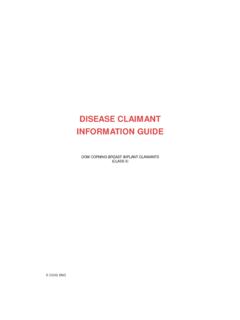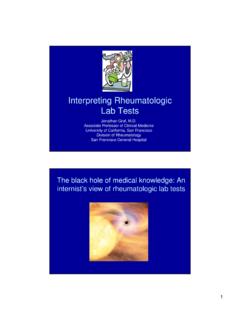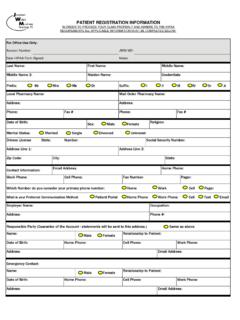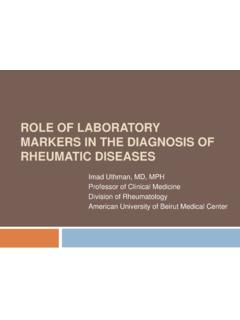Transcription of HIGHLIGHTS OF PRESCRIBING INFORMATION
1 Reference ID: 3324494 HIGHLIGHTS OF PRESCRIBING INFORMATION These HIGHLIGHTS do not include all the INFORMATION needed to use RAYOS safely and effectively. See full PRESCRIBING INFORMATION for RAYOS. RAYOS (prednisone) delayed-release tablets 1 mg, 2 mg, 5 mg Initial Approval: [1955] --------------------------- INDICATIONS AND USAGE ---------------------------- RAYOS is a corticosteroid indicated as an anti-inflammatory or immunosuppressive agent for certain allergic, dermatologic, gastrointestinal, hemat ologic, ophthalmologic, nervous system, renal, respiratory, rheumatologic, specific infectious diseases or conditions and organ transplantation (1 ) for the treatment of certain endocrine conditions (1) for palliation of certain neoplastic conditions (1) ----------------------- DOSAGE AND ADMINISTRATION ----------------------- Individualize dosing based on disease severity and patient response.
2 The timing of administration should take into account the delayed-release pharmacokinetics and the disease or condition being treated (2, ): Initial dose: RAYOS 5 mg administered once per day. Patients currently on immediate-release prednisone, prednisolone, or methylprednisolone should be switched to RAYOS at an equivalent dose based on relative potency. ( , ) Maintenance dose: Use lowest dosage that will maintain an adequate clinical response. ( ) Discontinuation: Withdraw gradually if discontinuing long-term or high-dose therapy. ( ) RAYOS should be taken daily with food. ( , ) RAYOS should be swallowed whole and not broken, divided, or chewed.
3 ( ) --------------------- DOSAGE FORMS AND STRENGTHS ---------------------- Delayed-release tablets: 1 mg, 2 mg, and 5 mg prednisone (3) ------------------------------ CONTRAINDICATIONS ------------------------------ Known hypersensitivity to prednisone or any excipients in the formulation (4, 6) ----------------------- WARNINGS AND PRECAUTIONS ------------------------ Hypothalamic-pituitary-adrenal (HPA) axis suppression, Cushing s syndrome, and hyperglycemia: Monitor patients for these conditions with chronic use. Taper doses gradually for withdrawal after chronic use. ( ) Infections: Increased susceptibility to new infection and increased risk of exacerbation, dissemination, or reactivation of latent infection.
4 Signs and symptoms of infection may be masked. ( ) Elevated blood pressure, salt and water retention, and hypokalemia: Monitor blood pressure and sodium, potassium serum levels ( ) GI perforation: increased risk in patients with certain GI disorders. Signs and symptoms may be masked. ( ) Behavioral and mood disturbances: May include euphoria, insomnia, mood swings, personality changes, severe depression, and psychosis. Existing conditions may be aggravated. ( ) Decreases in bone density: Monitor bone density in patients receiving long term corticosteroid therapy. ( ) Ophthalmic effects: May include cataracts, infections, and glaucoma. Monitor intraocular pressure if corticosteroid therapy is continued for more than 6 weeks ( ) Live or live attenuated vaccines: Do not administer to patients receiving immunosuppressive doses of corticosteroids.
5 ( ) Negative effects on growth and development: Monitor pediatric patients on long-term corticosteroid therapy. (5 .9) Use in pregnancy: Fetal harm can occur with first trimester use. Apprise women of potential harm to fetus. ( , ) ------------------------------ ADVERSE REACTIONS ------------------------------ Common adverse reactions for corticosteroids include fluid retention, alteration in glucose tolerance, elevation in blood pressure, behavioral and mood changes, increased appetite and weight gain. (6) To report SUSPECTED ADVERSE REACTIONS, contact Horizon Pharma USA, Inc. at 1-866-479-6742 or FDA at 1-800-FDA-1088 or ------------------------------ DRUG INTERACTIONS---------------------------- --- Anticoagulant agents: May enhance or diminish anticoagulant effects.
6 ( ) Antidiabetic agents: May increase blood glucose concentrations. Dose adjustments of antidiabetic agents may be required. ( ) CYP 3A4 inducers and inhibitors: May, respectively, increase or decrease clearance of corticosteroids, necessitating dose adjustment. ( , ) Cyclosporine: Increase in activity of both, cyclosporine and corticosteroid when administered concurrently. Convulsions have been reported with concurrent use. ( ) NSAIDs including aspirin and salicylates: Increased risk of gastrointestinal side effects. ( ) See 17 for PATIENT COUNSELING INFORMATION . Revised: [September 2017] FULL PRESCRIBING INFORMATION : CONTENTS* 1 INDICATIONS AND USAGE 2 DOSAGE AND ADMINISTRATION Recommended Dosing Recommended Monitoring Method of Administration Corticosteroid Comparison Chart 3 DOSAGE FORMS AND STRENGTHS 4 CONTRAINDICATIONS 5 WARNINGS AND PRECAUTIONS Alterations in Endocrine Function Increased Risks Related to Infection Alterations in Cardiovascular/Renal Function Use in Patients with Gastrointestinal Disorders Behavioral and Mood Disturbances Decrease in Bone Density Ophthalmic Effects Vaccination Effect on Growth and Development Use in Pregnancy Neuromuscular Effects Kaposi s Sarcoma 6 ADVERSE REACTIONS Clinical Trials Experience
7 Post marketing Experience 7 DRUG INTERACTIONS 8 USE IN SPECIFIC POPULATIONS Pregnancy Nursing Mothers Pediatric Use Geriatric Use 10 OVERDOSAGE 11 DESCRIPTION 12 CLINICAL PHARMACOLOGY Mechanism of Action Pharmacokinetics 13 NONCLINICAL TOXICOLOGY Carcinogenesis, Mutagenesis, Impairment of Fertility 14 CLINICAL STUDIES 16 HOW SUPPLIED/STORAGE AND HANDLING 17 PATIENT COUNSELING INFORMATION *Sections or subsections omitted from the full PRESCRIBING INFORMATION are not ID: 3324494 FULL PRESCRIBING INFORMATION 1 INDICATIONS AND USAGE RAYOS is indicated in the treatment of the following diseases or conditions: Allergic Conditions Control of severe or incapacitating allergic conditions intractable to adequate trials of conventional treatment in adults and pediatric populations with.
8 Atopic dermatitis Drug hypersensitivity reactions Seasonal or perennial allergic rhinitis Serum sickness Dermatologic Diseases Bullous dermatitis herpetiformis Contact dermatitis Exfoliative erythroderma Mycosis fungoides Pemphigus Severe erythema multiforme (Stevens-Johnson syndrome) Endocrine Conditions Congenital adrenal hyperplasia Hypercalcemia of malignancy Nonsuppurative thyroiditis Primary or secondary adrenocortical insufficiency: hydrocortisone or cortisone is the first choice: synthetic analogs may be us ed in conjunction with mineralocorticoids where applicable Gastrointestinal Diseases During acute episodes in: Crohn's Disease Ulcerative colitis Hematologic Diseases Acquired (autoimmune) hemolytic anemia Diamond-Blackfan anemia Idiopathic thrombocytopenic purpura in adults Pure red cell aplasia Secondary thrombocytopenia in adults Neoplastic Conditions For the treatment of.
9 Acute leukemia Aggressive lymphomas Nervous System Conditions Acute exacerbations of multiple sclerosis Cerebral edema associated with primary or metastatic brain tumor, craniotomy or head injury Reference ID: 3324494 Ophthalmic Conditions Sympathetic ophthalmia Uveitis and ocular inflammatory conditions unresponsive to topical steroids Conditions Related to Organ Transplantation Acute or chronic solid organ rejection Pulmonary Diseases Acute exacerbations of chronic obstructive pulmonary disease (COPD) Allergic bronchopulmonary aspergillosis Aspiration pneumonitis Asthma Fulminating or disseminated pulmonary tuberculosis when used concurrently with appropriate chemotherapy Hypersensitivity pneumonitis Idiopathic bronchiolitis obliterans with organizing pneumonia Idiopathic eosinophilic pneumonias Idiopathic pulmonary fibrosis Pneumocystis carinii pneumonia (PCP) associated with hypoxemia occurring in an HIV(+) individual who is al so under treatment with appropriate anti-PCP antibiotics.
10 Sympt omatic sarcoidosis Renal Conditions To induce a diuresis or remission of proteinuria in nephr otic syndrome, without uremia, of the idiopathic type or that due to lupus erythematosus Rheumat ologic Conditions As adjunctive therapy for short-term administration (to tide the patient over an acute episode or exacerbation) in: Acute gouty arthritis During an exacerbation or as maintenance therapy in selected cases of : Ankylosing spondylitis Dermat omyositis/polymyositis Polymyalgia rheumatica Psoriatic arthritis Relapsing polychondritis Rheumatoid arthritis, including juvenile rheumatoid arthritis (selected cases may require low dose maintenance therapy) Sjogren's syndrome Systemic lupus erythematosus Vasculitis Specific Infe ctious Diseases Trichinosis with neurologic or myocardial involvement.

